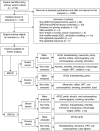Modifiers of cancer risk in BRCA1 and BRCA2 mutation carriers: systematic review and meta-analysis
- PMID: 24824314
- PMCID: PMC4081625
- DOI: 10.1093/jnci/dju091
Modifiers of cancer risk in BRCA1 and BRCA2 mutation carriers: systematic review and meta-analysis
Erratum in
- J Natl Cancer Inst. 2014 Aug;106(8):dju235 doi:10.1093/jnci/dju235
Abstract
Background: There is substantial variability in cancer risk in women who have inherited a BRCA1 or BRCA2 (BRCA1/2) mutation. Numerous factors have been hypothesized to modify these risks, but studies are of variable quality, and it remains unclear which of these may be of value in clinical risk assessment.
Methods: PubMed and Web of Science databases were searched for articles published through September 2013. Fixed effects meta-analysis was done using the hazard ratios and/or odds ratios to estimate the pooled effect estimates (ES) and 95% confidence intervals (CIs) to identify factors that are associated with cancer risk modification in BRCA1/2 mutation carriers.
Results: We identified 44 nonoverlapping studies that met predefined quality criteria. Sufficient evidence is available to make clinically relevant inferences about a number of cancer risk modifiers. The only variable examined that produced a probable association was late age at first live birth, a meta-analysis showed a decrease in the risk of breast cancer in BRCA1 mutation carriers with women aged 30 years or older vs. women younger than 30 years (ES = 0.65; 95% CI =0.42 to 0.99). The same was shown for women aged 25 to 29 years versus those aged less than 25 years (ES = 0.69; 95% CI = 0.48 to 0.99). Breastfeeding and tubal ligation were associated with reduced ovarian cancer risk in BRCA1 mutation carriers; oral contraceptives were associated with reduced risk among BRCA1/2 mutation carriers. Smoking was associated with increased breast cancer risk in BRCA2 mutation carriers only.
Conclusions: Data assessing many potential risk modifiers are inadequate, and many have not been externally validated. Although additional studies are required to confirm some associations, sufficient information is available for some risk factors to be used in risk counseling or lifestyle modification to minimize cancer risk in BRCA1/2 mutation carriers
Figures









References
-
- Miki Y, Swensen J, Shattuck-Eidens D, et al. A strong candidate for the breast and ovarian cancer susceptibility gene BRCA1. Science. 1994;266(5182):66–71 - PubMed
-
- Wooster R, Bignell G, Lancaster J, et al. Identification of the breast cancer susceptibility gene BRCA2. Nature. 1995;378(6559):789–792 - PubMed
-
- Goldgar DE, Fields P, Lewis CM, et al. A large kindred with 17q-linked breast and ovarian cancer: genetic, phenotypic, and genealogical analysis. J Natl Cancer Inst. 1994;86(3):200–209 - PubMed
-
- Begg CB. On the use of familial aggregation in population-based case probands for calculating penetrance. J Natl Cancer Inst. 2002;94(16):1221–1226 - PubMed
Publication types
MeSH terms
Substances
Grants and funding
LinkOut - more resources
Full Text Sources
Other Literature Sources
Medical
Miscellaneous

